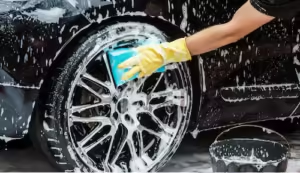Waterless car wash products are a fantastic way to conserve water while keeping your vehicle clean. These products come in the form of sprays or wipes that lift dirt and grime from your car’s surface without the need for rinsing. Simply apply the product, wipe with a microfiber cloth, and your car is clean. Waterless car washes are especially useful for quick clean-ups and for maintaining your car between more thorough washes.
Use a Foam Cannon with a Water Recycling System
Foam cannons are effective at lifting dirt and grime, and when paired with a water recycling system, they become even more eco-friendly. These systems capture and filter the used water, allowing it to be reused for subsequent washes. By reducing water waste, you not only save resources but also ensure a thorough and efficient cleaning process. Foam cannons also help to minimize the amount of soap needed, as the foam spreads evenly and clings to the surface, enhancing the cleaning effect.
Choose Biodegradable Soaps
When selecting car wash soaps, opt for biodegradable options that break down naturally and have a lower environmental impact. Traditional soaps and detergents can contain harmful chemicals that run off into the environment, potentially contaminating waterways. Biodegradable soaps are designed to be less harmful and will break down more quickly, reducing their impact on the environment.
Implement the Two-Bucket Method
The two-bucket method is an excellent technique for reducing water waste and ensuring a more efficient wash. Fill one bucket with soapy water and another with clean water for rinsing. As you wash your car, dip your wash mitt in the soapy water, and rinse it in the clean water before reapplying soap. This method helps to keep your wash water cleaner for longer, reducing the need for frequent changes and minimizing water usage.
Utilize a High-Efficiency Pressure Washer
A high-efficiency pressure washer can significantly reduce water consumption while providing a powerful cleaning performance. These devices are designed to use less water compared to traditional hoses, making them a more sustainable choice. By adjusting the pressure settings, you can ensure that you’re using the appropriate amount of water for different cleaning tasks, thereby conserving resources and reducing waste.
Wash Your Car During Rainy Seasons
If possible, take advantage of rainy weather to wash your car. Rain can help rinse off loose dirt and debris, reducing the amount of water and soap needed for a full wash. While you still need to clean your car thoroughly, using rainwater as a preliminary rinse can help minimize water consumption. Just make sure to use eco-friendly products to ensure that any runoff is less harmful to the environment.
Avoid Washing on Paved Surfaces
Washing your car on a grassy or gravel surface can help reduce the amount of runoff that enters storm drains. Paved surfaces, such as driveways, tend to direct runoff into storm drains, which can carry pollutants to local waterways. By washing on a natural surface, you allow the water to be absorbed and filtered more naturally, minimizing the impact on the environment.
Dry with a Microfiber Towel
Instead of using a hose to rinse off excess water, use a microfiber towel to dry your car after washing. Microfiber towels are highly absorbent and effective at removing water without leaving streaks or spots. This method helps conserve water and reduces the need for additional rinsing, making your car washing process more eco-friendly.
Recycle and Dispose of Waste Properly
Proper disposal of car wash waste is crucial for environmental protection. Ensure that any used cleaning products, containers, and towels are recycled or disposed of according to local regulations. Avoid pouring soapy water down storm drains, as it can contaminate water sources. Instead, collect the wastewater and dispose of it in a manner that prevents environmental harm.
Maintenance to Reduce the Need for Frequent Washes
Regular maintenance of your vehicle can help reduce the frequency of car washes. Keeping your car clean and protected with a wax or sealant can help prevent dirt and grime from adhering to the surface, making each wash more effective and less frequent. By maintaining your car’s appearance, you can extend the time between washes and reduce overall water usage.
Conclusion
Adopting eco-friendly car wash practices in 2024 not only helps to conserve water and reduce waste but also contributes to a healthier environment. By utilizing waterless products, biodegradable soaps, and efficient washing techniques, you can keep your vehicle clean while minimizing your environmental impact. Embrace these tips to make your car wash routine more sustainable and to protect our planet for future generations.
FAQs
1. What are the benefits of using waterless car wash products?
Waterless car wash products conserve water, are convenient for quick clean-ups, and help reduce the overall environmental impact of car washing.
2. How does a water recycling system work in car washes?
A water recycling system captures and filters used water so that it can be reused for subsequent washes, reducing overall water consumption and waste.
3. Why should I choose biodegradable soaps for car washing?
Biodegradable soaps break down more quickly and are less harmful to the environment, reducing the impact on waterways and ecosystems.
4. Can washing my car on a grassy surface really make a difference?
Yes, washing on a grassy or natural surface allows water to be absorbed and filtered more naturally, reducing runoff into storm drains and minimizing environmental impact.
5. How can regular maintenance help reduce car wash frequency?
Regular maintenance, such as applying wax or sealant, helps protect your vehicle’s surface and prevents dirt and grime from sticking, extending the time between washes and reducing overall water use.




